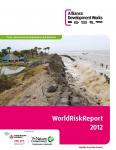
Brussels, 11 October 2012. Environmental degradation is a significant factor that reduces the adaptive capacity of societies to deal with disaster risk in many countries around the globe. The balance sheet for the ten years from 2002 to 2011 is alarming: 4,130 disasters, over one million dead and economic losses of at least 1.195 trillion US dollars. This is demonstrated by the second edition of the WorldRiskReport launched in Brussels today.
The report is presented by the United Nations University Institute for Environment and Human Security (UNU‐EHS), the Alliance Development Works/Bündnis Entwicklung Hilft and The Nature Conservancy (TNC). The Alliance is the publisher of the report. The centerpiece of the report, the WorldRiskIndex, developed by UNU‐EHS in Bonn in cooperation with the Alliance determines the risk of becoming the victim of a disaster as a result of natural hazards for 173 countries throughout the world. According to the presently available data, the Pacific Island state of Vanuatu has the highest disaster risk, at 36.31 per cent. Malta and Qatar, at 0.61 and 0.10 per cent respectively, face the lowest risk worldwide. At 3.48 per cent Belgium ranks 142th and is therefore in the lowest of the five risk categories. Additionally, the 2012 report highlights the aspect of environmental degradation and disasters.
The risk calculated by the index is determined by the extent to which communities are exposed to natural hazards such as droughts, storms or earthquakes, but also by their degree of vulnerability. The latter is dependent on social factors such as the public infrastructure, medical services, the prevailing nutritional situation, governance, the level of education, the availability of insurances that might help to deal with economic losses in an event, as well as the condition of the environment.
"The WorldRiskIndex reveals global hotspots for disaster risk in Oceania, Southeast Asia, the southern Sahel and especially in Central America and the Caribbean. In these places a very high threat of natural disasters and climate change meets very vulnerable communities," explained Prof. Dr. Jakob Rhyner, UNU‐EHS Director.
| Attachment | Size |
|---|---|
| 2.82 MB |
-

- Log in to post comments
- 182 reads


